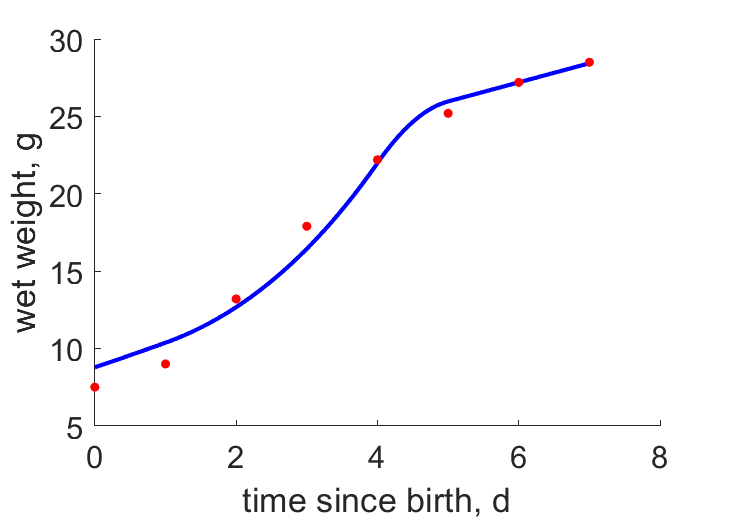Predictions & Data for this entry
| Model: std | climate: Cfa, Dfa, Dfb | migrate: Ml | phylum: |
| COMPLETE = 2.5 | ecozone: THn | food: biCi | class: |
| MRE = 0.026 | habitat: 0iTh, 0iTf, 0iTi | gender: Dg | order: |
| SMSE = 0.002 | embryo: Tnpo | reprod: O | family: |
Zero-variate data
| Data | Observed | Predicted | (RE) | Unit | Description | Reference |
|---|---|---|---|---|---|---|
| ab | 12 | 11.59 | (0.03424) | d | age at birth | avibase |
| tx | 21 | 20.98 | (0.0008777) | d | time since birth at fledging | avibase |
| tp | 63 | 69.11 | (0.097) | d | time since birth at puberty | guess |
| tR | 365 | 365 | ( 0) | d | time since birth at 1st brood | avibase |
| am | 1825 | 1820 | (0.002773) | d | life span | avibase |
| Ww0 | 6.3 | 12.99 | (1.062) | g | initial wet weight | avibase |
| Wwb | 7.5 | 7.832 | (0.04429) | g | wet weight at birth | Spen1943 |
| Wwi | 48.5 | 48.73 | (0.004721) | g | ultimate wet weight | avibase |
| Wwim | 45.8 | 45.8 | (7.984e-05) | g | ultimate wet weight for males | avibase |
| Ri | 0.007397 | 0.007632 | (0.03175) | #/d | maximum reprod rate | avibase |
Uni- and bivariate data
| Data | Figure | Independent variable | Dependent variable | (RE) | Reference |
|---|---|---|---|---|---|
| tW |  | time since birth | wet weight | (0.03771) | Spen1943 |
Pseudo-data at Tref = 20°C
| Data | Generalised animal | Coccyzus erythropthalmus | Unit | Description |
|---|---|---|---|---|
| v | 0.02 | 0.07969 | cm/d | energy conductance |
| p_M | 18 | 450.6 | J/d.cm^3 | vol-spec som maint |
| k_J | 0.002 | 0.01851 | 1/d | maturity maint rate coefficient |
| k | 0.3 | 0.3006 | - | maintenance ratio |
| kap | 0.8 | 0.6888 | - | allocation fraction to soma |
| kap_G | 0.8 | 0.8008 | - | growth efficiency |
| kap_R | 0.95 | 0.95 | - | reproduction efficiency |
Discussion
- Body temperature guessed
- Relative food intake reduced just before fledging
- Males are supposed to differ from females by {p_Am} only
- Ww0 data was ignorned, due to inconsistency wit tW data
- mod_1: Pseudo-data point k is used, rather than k_J; Data set tp and parameter t_R are added, the latter replacing clutch interval t_N. Postnatal T is based on PrinPres1991, see get_T_Aves. See further the revision page, theme puberty
Bibliography